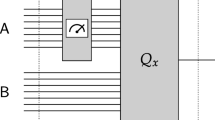Abstract
This paper studies quantum refereed games, which are quantum interactive proof systems with two competing provers: one that tries to convince the verifier to accept and the other that tries to convince the verifier to reject. We prove that every language having an ordinary quantum interactive proof system also has a quantum refereed game in which the verifier exchanges just one round of messages with each prover. A key part of our proof is the fact that there exists a single quantum measurement that reliably distinguishes between mixed states chosen arbitrarily from disjoint convex sets having large minimal trace distance from one another. We also show how to reduce the probability of error for some classes of quantum refereed games.
Preview
Unable to display preview. Download preview PDF.
Similar content being viewed by others
References
Goldwasser, S., Micali, S., Rackoff, C.: The knowledge complexity of interactive proof systems. SIAM Journal on Computing 18, 186–208 (1989)
Babai, L.: Trading group theory for randomness. In: Proceedings of the Seventeenth Annual ACM Symposium on Theory of Computing, pp. 421–429 (1985)
Babai, L., Moran, S.: Arthur-Merlin games: a randomized proof system, and a hierarchy of complexity classes. Journal of Computer and System Sciences 36, 254–276 (1988)
Ben-Or, M., Goldwasser, S., Kilian, J., Wigderson, A.: Multi-prover interactive proofs: how to remove intractability assumptions. In: Proceedings of the Twentieth Annual ACM Symposium on Theory of Computing, pp. 113–131 (1988)
Reif, J.: The complexity of two-player games of incomplete information. Journal of Computer and System Sciences 29, 274–301 (1984)
Feige, U., Shamir, A., Tennenholtz, M.: The noisy oracle problem. In: Goldwasser, S. (ed.) CRYPTO 1988. LNCS, vol. 403, pp. 284–296. Springer, Heidelberg (1990)
Feige, U., Shamir, A.: Multi-oracle interactive protocols with constant space verifiers. Journal of Computer and System Sciences 44, 259–271 (1992)
Koller, D., Megiddo, N.: The complexity of two-person zero-sum games in extensive form. Games and Economic Behavior 4, 528–552 (1992)
Feigenbaum, J., Koller, D., Shor, P.: A game-theoretic classification of interactive complexity classes. In: Proceedings of the 10th Conference on Structure in Complexity Theory, pp. 227–237 (1995)
Feige, U., Kilian, J.: Making games short. In: Proceedings of the Twenty-Ninth annual ACM Symposium on Theory of Computing, pp. 506–516 (1997)
Lund, C., Fortnow, L., Karloff, H., Nisan, N.: Algebraic methods for interactive proof systems. Journal of the ACM 39, 859–868 (1992)
Shamir, A.: IP = PSPACE. Journal of the ACM 39, 869–877 (1992)
Shen, A.: IP = PSPACE: simplified proof. Journal of the ACM 39, 878–880 (1992)
Watrous, J.: PSPACE has constant-round quantum interactive proof systems. Theoretical Computer Science 292, 575–588 (2003)
Kitaev, A., Watrous, J.: Parallelization, amplification, and exponential time simulation of quantum interactive proof system. In: Proceedings of the 32nd ACM Symposium on Theory of Computing, pp. 608–617 (2000)
Aharonov, D., Kitaev, A., Nisan, N.: Quantum circuits with mixed states. In: Proceedings of the Thirtieth Annual ACM Symposium on Theory of Computing, pp. 20–30 (1998)
Rosgen, B., Watrous, J.: On the hardness of distinguishing mixed-state quantum computations (2004), arXiv.org e-Print cs.CC/0407056
Bhatia, R.: Matrix Analysis. Springer, Heidelberg (1997)
Rockafellar, R.T.: Convex Analysis. Princeton University Press, Princeton (1970)
Fuchs, C., van de Graaf, J.: Cryptographic distinguishability measures for quantum-mechanical states. IEEE Transactions on Information Theory 45, 1216–1227 (1999)
Raz, R.: A parallel repetition theorem. SIAM Journal of Computing 27, 763–803 (1998)
Kitaev, A., Shen, A., Vyalyi, M.: Classical and Quantum Computation. Graduate Studies in Mathematics, vol. 47. American Mathematical Society, Providence (2002)
Author information
Authors and Affiliations
Editor information
Editors and Affiliations
Rights and permissions
Copyright information
© 2005 Springer-Verlag Berlin Heidelberg
About this paper
Cite this paper
Gutoski, G., Watrous, J. (2005). Quantum Interactive Proofs with Competing Provers. In: Diekert, V., Durand, B. (eds) STACS 2005. STACS 2005. Lecture Notes in Computer Science, vol 3404. Springer, Berlin, Heidelberg. https://doi.org/10.1007/978-3-540-31856-9_50
Download citation
DOI: https://doi.org/10.1007/978-3-540-31856-9_50
Publisher Name: Springer, Berlin, Heidelberg
Print ISBN: 978-3-540-24998-6
Online ISBN: 978-3-540-31856-9
eBook Packages: Computer ScienceComputer Science (R0)




